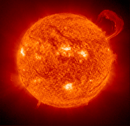Pioneer H

Pioneer H is an unlaunched unmanned space mission that was part of the US Pioneer program for a planned 1974 launch. Had this mission and spacecraft been launched, it would have been designated Pioneer 12; that designation was later applied to the Pioneer Venus Orbiter.
As planning for the Pioneer 10 and 11 missions progressed, mission scientists found themselves desiring a third probe. In 1971, a formal mission study was proposed for a spacecraft to be launched to Jupiter in 1974, where it would use the gas giant as a gravitational slingshot to travel outside the ecliptic. This was the first Out-Of-The-Ecliptic mission (OOE) proposed, for Jupiter and solar (Sun) observations.[1]
NASA/Ames Research Center would have managed the project. The NASA contractor TRW Systems Group (formerly Space Technology Laboratories) would have constructed Pioneer H from the flight-qualified spare components intended for the Pioneer F and G probes (designated Pioneer 10 and Pioneer 11 after launch).

NASA management did not approve the mission proposal, and it was never launched in 1974. In 1976 NASA transferred the craft (without RTG) to the Smithsonian Institution. In January 1977, Pioneer H was moved to the National Air and Space Museum, where it was eventually displayed as a replica of Pioneer 10.
Ulysses mission
As far as its successors, in 1979 two spacecraft were planned to be built by NASA and ESA, as the "International Solar Polar Mission" (ISPM). One would be sent over Jupiter, then under the Sun. The other would fly under Jupiter, then over the Sun. This would provide simultaneous coverage and scientific measurements. Due to budget cutbacks, the US sponsored spacecraft for the ISPM was canceled in 1981.
Eventually, one spacecraft was designed, and the project recast as Ulysses due to the indirect and untried flight path, Out-Of-The-Ecliptic (OOE). NASA would provide the Radioisotope Thermoelectric Generator (RTG) and launch services, The European Space Agency would build the spacecraft assigned to Astrium GmbH, Friedrichshafen, Germany (formerly Dornier Systems). The instruments would be split into teams from universities and research institutes in Europe and the United States. This process provided the 10 instruments on board. The Pioneer H mission, first proposed in 1971 by the Pioneer 10/11 principal investigators, was finally launched 20 years later.
NASA New Frontiers program
In 2003, funding was added to the NASA budget for the New Frontiers Program. [2] The second mission selected under this program was a Jupiter Polar Orbiter with Probes. This mission desired to understand Jupiter's internal structure, magnetic field/magnetosphere, water abundance, and deep atmospheric composition. Pioneer H scientific observations at Jupiter (magnetometer) planned for the OOE slingshot flyby, would be one of the scientific objectives of this polar orbiting spacecraft (Juno).
Juno mission
The NASA New Frontiers Juno mission was launched from Cape Canaveral Air Force Station on August 5, 2011.[3] The Juno spacecraft will be placed in a polar orbit to study the planet's composition, gravity field, magnetic field, and polar magnetosphere.
The Juno spacecraft's suite of science instruments will:
- Determine the ratio of oxygen to hydrogen, effectively measuring the abundance of water in Jupiter, which will help distinguish among prevailing theories linking the gas giant's formation to the solar system.
- Obtain a better estimate of Jupiter's core mass, which will also help distinguish among prevailing theories linking the gas giant's formation to the solar system.
- Precisely map Jupiter's gravity to assess the distribution of mass in Jupiter's interior, including properties of the planet's structure and dynamics.
- Precisely map Jupiter's magnetic field to assess the origin and structure of the field and how deep in Jupiter the magnetic field is created. This experiment also will help scientists understand the fundamental physics of dynamo theory.
- Map the variation in atmospheric composition, temperature, structure, cloud opacity and dynamics to pressures far greater than 100 bars (10 MPa; 1450 pound/sq inch) at all latitudes.
- Characterize and explore the three-dimensional structure of Jupiter's polar magnetosphere and its auroras.[4]
Current location

Pioneer H hangs in the Milestones of Flight Gallery at the National Air and Space Museum in Washington, D.C., serving as a stand-in for the Pioneer 10 probe. [5]
While described in official Smithsonian records as a "replica", the spacecraft was considered fully functional by Pioneer mission planners (though its RTGs were never installed). Mark Wolverton quotes James Van Allen in The Depths of Space: [6]
- "We mounted an intensive campaign to launch the flight-worthy spare spacecraft and its instrument complement on a low-cost, out-of-ecliptic mission via a high-inclination flyby of Jupiter. However, our case fell on deaf ears at NASA headquarters, and the spare spacecraft now hangs in the main gallery of the National Air and Space Museum, at 1 AU and zero ecliptic latitude."
References
- ↑ "Pioneer H, Jupiter Swingby Out-of-the-Ecliptic Mission Study" (PDF). 20 August 1971. Retrieved 2 May 2012.
- ↑ "NASA New Frontiers Program". 5 August 2011. Retrieved 2 May 2012.
- ↑ Dunn, Marcia (5 August 2011). "NASA probe blasts off for Jupiter after launch-pad snags". MSN. Retrieved 31 August 2011.
- ↑ "Juno Science Objectives". University of Wisconsin-Madison. Retrieved October 13, 2008.
- ↑ "Assembling for NASM the Pioneer 10 replica". NASM Space Archives. Retrieved 2 May 2012.
- ↑ "The Depths of Space". The National Academies Press. Retrieved 2 May 2012.
External links
- The Depths of Space: The Story of the Pioneer Planetary Probes, Mark Wolverton, 2004
- National Air and Space Museum - Pioneer 10 - Milestones of Flight
- Assembling for NASM the Pioneer 10 replica
- International Solar Polar mission, 1979
| |||||||||||||||||||||||||||||||||||||||||
| ||||||||||||||||||||
| ||||||||||||||||||||||||



